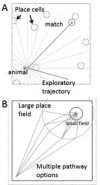Models of spatial and temporal dimensions of memory
- PMID: 29130060
- PMCID: PMC5675108
- DOI: 10.1016/j.cobeha.2017.05.024
Models of spatial and temporal dimensions of memory
Abstract
Episodic memory involves coding of the spatial location and time of individual events. Coding of space and time is also relevant to working memory, spatial navigation, and the disambiguation of overlapping memory representations. Neurophysiological data demonstrate that neuronal activity codes the current, past and future location of an animal as well as temporal intervals within a task. Models have addressed how neural coding of space and time for memory function could arise, with both dimensions coded by the same neurons. Neural coding could depend upon network oscillatory and attractor dynamics as well as modulation of neuronal intrinsic properties. These models are relevant to the coding of space and time involving structures including the hippocampus, entorhinal cortex, retrosplenial cortex, striatum and parahippocampal gyrus, which have been implicated in both animal and human studies.
Conflict of interest statement
The authors declare no conflict of interests.
Figures



Similar articles
-
Neurophysiological coding of space and time in the hippocampus, entorhinal cortex, and retrosplenial cortex.Brain Neurosci Adv. 2020 Nov 30;4:2398212820972871. doi: 10.1177/2398212820972871. eCollection 2020 Jan-Dec. Brain Neurosci Adv. 2020. PMID: 33294626 Free PMC article. Review.
-
Episodic memory: Neuronal codes for what, where, and when.Hippocampus. 2019 Dec;29(12):1190-1205. doi: 10.1002/hipo.23132. Epub 2019 Jul 23. Hippocampus. 2019. PMID: 31334573 Review.
-
Potential roles of cholinergic modulation in the neural coding of location and movement speed.J Physiol Paris. 2016 Sep;110(1-2):52-64. doi: 10.1016/j.jphysparis.2016.09.002. Epub 2016 Sep 24. J Physiol Paris. 2016. PMID: 27677935 Free PMC article. Review.
-
Distance and Direction Codes Underlie Navigation of a Novel Semantic Space in the Human Brain.J Neurosci. 2020 Mar 25;40(13):2727-2736. doi: 10.1523/JNEUROSCI.1849-19.2020. Epub 2020 Feb 14. J Neurosci. 2020. PMID: 32060171 Free PMC article.
-
Electrical Stimulation in Hippocampus and Entorhinal Cortex Impairs Spatial and Temporal Memory.J Neurosci. 2018 May 9;38(19):4471-4481. doi: 10.1523/JNEUROSCI.3049-17.2018. Epub 2018 Apr 10. J Neurosci. 2018. PMID: 29636396 Free PMC article.
Cited by
-
The Persistence of Memory: How the Brain Encodes Time in Memory.Curr Opin Behav Sci. 2017 Oct;17:178-185. doi: 10.1016/j.cobeha.2017.09.003. Curr Opin Behav Sci. 2017. PMID: 29915793 Free PMC article.
-
Time Makes Space: Emergence of Place Fields in Networks Encoding Temporally Continuous Sensory Experiences.ArXiv [Preprint]. 2025 Jul 9:arXiv:2408.05798v3. ArXiv. 2025. PMID: 39975441 Free PMC article. Preprint.
-
Memory updating and the structure of event representations.Trends Cogn Sci. 2025 Apr;29(4):380-392. doi: 10.1016/j.tics.2024.11.008. Epub 2024 Dec 11. Trends Cogn Sci. 2025. PMID: 39668061 Free PMC article. Review.
-
Disruption of the grid cell network in a mouse model of early Alzheimer's disease.Nat Commun. 2022 Feb 16;13(1):886. doi: 10.1038/s41467-022-28551-x. Nat Commun. 2022. PMID: 35173173 Free PMC article.
-
Episodic time in the brain: A new world order.Learn Behav. 2020 Jun;48(2):189-190. doi: 10.3758/s13420-019-00379-4. Learn Behav. 2020. PMID: 30945171 Free PMC article.
References
-
- Brown TI, Stern CE. Contributions of medial temporal lobe and striatal memory systems to learning and retrieving overlapping spatial memories. Cereb Cortex. 2014;24:1906–1922. Study showing fMRI activation in the hippocampus when viewing the initial location of an overlapping trajectory and retrieving the full trajectory to generate a correct response. - PMC - PubMed
-
- Brown TI, Carr VA, LaRocque KF, Favila SE, Gordon AM, Bowles B, Bailenson JN, Wagner AD. Prospective representation of navigational goals in the human hippocampus. Science. 2016;352:1323–1326. Multi-voxel pattern analysis of fMRI data showing that retrieval of a trajectory to a different location on a circular pathway involves reactivation of the representation of intermediate locations along that trajectory. - PubMed
Grants and funding
LinkOut - more resources
Full Text Sources
Other Literature Sources
Miscellaneous
